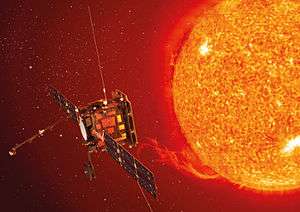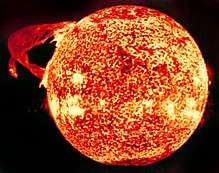Solar Orbiter
 Artist's impression of ESA's Solar Orbiter | |||||||||||||||||||||||
| Mission type | Solar heliophysics orbiter | ||||||||||||||||||||||
|---|---|---|---|---|---|---|---|---|---|---|---|---|---|---|---|---|---|---|---|---|---|---|---|
| Operator | ESA & NASA | ||||||||||||||||||||||
| Website |
sci | ||||||||||||||||||||||
| Mission duration |
7 years (nominal) 10 years (extended)[1] | ||||||||||||||||||||||
| Spacecraft properties | |||||||||||||||||||||||
| Manufacturer | Astrium UK | ||||||||||||||||||||||
| Launch mass | 1,800 kg (4,000 lb)[1] | ||||||||||||||||||||||
| Payload mass | ~190 kg (420 lb)[1] | ||||||||||||||||||||||
| Dimensions | 2.5 m × 3 m (8.2 ft × 9.8 ft)[1] | ||||||||||||||||||||||
| Power | 1100 watts[1] | ||||||||||||||||||||||
| Start of mission | |||||||||||||||||||||||
| Launch date | 2020[2] | ||||||||||||||||||||||
| Rocket | Atlas V 411[3] | ||||||||||||||||||||||
| Launch site | Cape Canaveral SLC-41 | ||||||||||||||||||||||
| Contractor | United Launch Alliance | ||||||||||||||||||||||
| Orbital parameters | |||||||||||||||||||||||
| Reference system | Heliocentric | ||||||||||||||||||||||
| Regime | Elliptic orbit | ||||||||||||||||||||||
| Perihelion | 0.28 AU | ||||||||||||||||||||||
| Aphelion | 0.8-0.9 AU | ||||||||||||||||||||||
| Inclination | 0-34 degrees | ||||||||||||||||||||||
| Period | 150 days | ||||||||||||||||||||||
| Epoch | planned | ||||||||||||||||||||||
| Main | |||||||||||||||||||||||
| Type | Ritchey–Chrétien reflector | ||||||||||||||||||||||
| Diameter | 160 mm (6.3 in) | ||||||||||||||||||||||
| Focal length | 2.5 m (8.2 ft) | ||||||||||||||||||||||
| Wavelengths | visible light, ultraviolet, X-rays | ||||||||||||||||||||||
| |||||||||||||||||||||||
|
| |||||||||||||||||||||||
Solar Orbiter (SolO) is a planned Sun-observing satellite, under development by the European Space Agency (ESA). The mission will be launched with an Atlas V from the Cape Canaveral AFS in Florida in 2020.[2] SolO is intended to perform detailed measurements of the inner heliosphere and nascent solar wind, and perform close observations of the polar regions of the Sun, which is difficult to do from Earth, both serving to answer the question 'How does the Sun create and control the heliosphere?'
The Solar Orbiter will make observations of the Sun from an eccentric orbit moving as close as ~60 solar radii (RS), or 0.284 astronomical units (AU), placing it inside Mercury's perihelion of 0.3075 AU.[4] During the planned 7 year mission the orbital inclination will be raised to about 25°.[5]

Scientific objectives
The spacecraft will make a close approach to the Sun every five months. The closest approach will be positioned to allow a repeated study of the same region of the solar atmosphere. Solar Orbiter will be able to watch magnetic activity building up in the atmosphere that can lead to powerful solar flares or eruptions.
Researchers will also have the chance to co-ordinate observations with NASA's Parker Solar Probe mission (2018 - 2025) which will make in situ measurements in the Sun's extended corona.
The objective of the mission is to perform close-up, high-resolution studies of the Sun and its inner heliosphere. The new understanding will help answer these questions:
- How and where do the solar wind plasma and magnetic field originate in the corona?
- How do solar transients drive heliospheric variability?
- How do solar eruptions produce energetic particle radiation that fills the heliosphere?
- How does the solar dynamo work and drive connections between the Sun and the heliosphere?
Payload
The science payload is composed of: [2]
- Heliospheric in-situ instruments
- Solar Wind Analyser (SWA): To measure solar wind properties and composition[6]
- Energetic Particle Detector (EPD): To measure suprathermal ions, electrons, neutral atoms, as well as energetic particles in the energy range from few keV/nuc to relativistic electrons and ions up to 100 MeV (protons) and 200 MeV/nuc (heavy ions)[7]
- Magnetometer (MAG): will provide detailed measurements of the magnetic field[8]
- Radio and Plasma Wave analyser (RPW): To measure magnetic and electric fields at high time resolution[9]
- Solar remote-sensing instruments
- Polarimetric and Helioseismic Imager (PHI): To provide high-resolution and full-disk measurements of the photospheric magnetic field[10]
- EUV full-Sun and high-resolution Imager (EUI): To image various layers of the solar atmosphere
- EUV spectral Imager (SPICE): To provide spectral imaging of solar disk and corona, characterise plasma properties at the Sun[11]
- Spectrometer Telescope for Imaging X-rays (STIX): To provide imaging spectroscopy of thermal and non-thermal solar X-ray emission from 4 to 150 keV
- Coronagraph (Metis): To provide simultaneous UV (121.6 nm), and polarised visible light imaging of the corona[12]
- Heliospheric Imager (SoloHI): To image quasi-steady and transient flows of the solar wind (US provided)[13]
Timeline and status
- 2012 April : €300M contract to build orbiter awarded to Astrium UK.[14]
- 2014 June : Solar shield completes 2 week bake test.[15]
Launch delays
In April 2015 the launch was set back from July 2017 to October 2018.[16] In August 2017 Solar Orbiter was considered "on track" to be launched in February 2019.[17] As of August 2018 the launch is "foreseen for 2020".[2]
Trajectory
After launch, the Orbiter will take approximately 3.5 years, using repeated gravity assists from Earth and Venus, to reach its operational orbit, an elliptical orbit with perihelion 0.28 AU and aphelion 0.9 AU. Over the expected mission duration of 7 years, it will use additional gravity assists from Venus to raise its inclination from 0° to 25°, allowing it a better view of the Sun's poles. If an extended mission is approved, the inclination could rise further to 34°.[5][18]
See also
- Advanced Composition Explorer (ACE), launched 1997, still operational
- French space program
- Parker Solar Probe, launched in August 2018
- Solar Sentinels, proposed 2006 and 2008
- Space sunshade
- STEREO (Solar Terrestrial Relations Observatory), launched 2006, still operational
- WIND, launched 1994, still operational
- Ulysses, launched 1990
References
- 1 2 3 4 5 "Solar Orbiter Mission". ESA eoPortal. Retrieved 2015-03-17.
- 1 2 3 4 "Solar Orbiter". European Space Agency. Retrieved 2 August 2018.
- ↑ "NASA Selects United Launch Alliance Atlas V Rocket to Launch Solar Orbiter Mission". United Launch Alliance. Digital Journal. 18 March 2014. Retrieved 2014-03-19.
- ↑ "Kiepenheuer-Institut fuer Sonnenphysik: SolarOrbiter PHI-ISS". Kis.uni-freiburg.de. Retrieved 9 August 2018.
- 1 2 "ESA Science & Technology: Mission Operations". Sci.esa.int. 13 April 2015. Retrieved 20 March 2018.
- ↑ "Solar Orbiter". Ucl.ac.uk. Retrieved 9 August 2018.
- ↑ "Solar Orbiter's Energetic Particle Detector (EPD)". Retrieved 7 September 2018.
- ↑ "Space and Atmospheric Physics". Imperial College London. Retrieved 9 August 2018.
- ↑ "La mission Solar Orbiter - LESIA - Observatoire de Paris". Lesia.obspm.fr. Retrieved 9 August 2018.
- ↑ "MPS: PHI: Polarimetric and Helioseismic Imager". Web.archive.org. 16 May 2012. Retrieved 9 August 2018.
- ↑ "MPS: SPICE: Spectral Imaging of the Coronal Environment". Web.archive.org. 11 May 2011. Retrieved 9 August 2018.
- ↑ "Metis Solar Orbiter". Metis.oato.inaf.it. Retrieved 9 August 2018.
- ↑ "Solar Orbiter Heliospheric Imager (SoloHI) - Space Science Division". Nrl.navy.mil. Retrieved 9 August 2018.
- ↑ "ESA contracts Astrium UK to build Solar Orbiter". Sci.esa.int. April 2012.
- ↑ "Solar Orbiter's shield takes Sun's heat". Esa.int. June 2014.
- ↑ http://sci.esa.int/solar-orbiter/55772-solar-orbiter-launch-moved-to-2018/
- ↑ "Europe's Solar Orbiter on track for 2019 launch". Air & Cosmos. 28 August 2017. Retrieved 19 September 2017.
- ↑ "ESA Science & Technology: Summar". Sci.esa.inty. 28 February 2018. Retrieved 20 March 2018.
External links
| Wikimedia Commons has media related to Solar Orbiter. |



